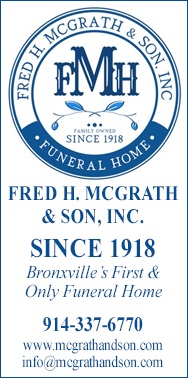From the Mayor: Parking: Searching for Solutions While Taking into Account So Many Variables

By Mary C. Marvin, Mayor, Village of Bronxville
Jul. 11, 2018: Village Administrator Jim Palmer and I recently attended a parking seminar sponsored by the Urban Land Institute. Given the parking needs/constraints/potential opportunities in our village, we thought it well worth our time and we weren’t disappointed.
Overview
The United States has 260 million cars and currently 800 million spots, so the inventory is not scarce, rather, location is the issue. Not surprisingly, all the compiled data reaffirm that driverless cars are coming and ride sharing is gaining ground. With them come the anticipated problems of even more gridlocked streets as cars are programmed to head home after drop-off or continue on to a new destination. Cyber hacking is also definitely in the mix. All the experts thought that even with the burgeoning popularity of Uber and Lyft, combined with new technology, parking needs for the next 10 to 15 years would not change appreciably. Data confirm car-sharing services are replacing taxies, rental cars, and bus transportation, not car ownership and rail service.
Americans still have a unique love affair with cars. We are, unlike our peers in Asia and Europe, in fact very slow to embrace technology that takes our cars away from us in the form of automated or stackable parking. Many unique reasons account for this.
It starts with an abundance of land to personally park vehicles that our counterparts in Asia and Europe never had. Psychologically, we also don’t like to give over a prized possession, and we certainly cannot tolerate wait time as a vehicle is retrieved. (Almost 20 years ago, a fully automated state-of-the-art parking garage was opened in Hoboken. Not long after its debut, cars fell from upper decks, setting the industry back decades, according to experts.)
So looking at a parking paradigm that is not going to change a great deal in the foreseeable future, the solution is to manage what we have in the most efficient way possible and/or build so that the structures can be retrofitted if another use comes to light. This requires municipalities to first turn inward and look at local codes, 24/7 patterns, overnight parking, meter timing, fee structures, shuttles, valets, and traffic patterns. We are doing all of the above in the context of our recently launched village comprehensive plan.
On the building front, the trend is for open-air garages to be zoned for much higher first floors and narrower ramps so mixed-use is an option.
Even meters must be looked at as a performance measurer–are they helping abutting businesses to move traffic/customers–and much less as a revenue generator.
In a very interesting experiment, Summit, NJ, just decided to forgo any new parking lots/structures and has contracted with Uber, at a cost of $175,000 per year, to ferry the overflow residents to the train station. It is too early to tell if it is a success.
The great news is that Bronxville is so in style–if we were ever out!–as a model TOD (Transit-Oriented Development). Data clearly validate that all age groups, with a particular emphasis on millennials, want to be within walking distance of public transportation, stores, schools, and medical services. The benefits are enormous both environmentally and socially. Dependence on the automobile is reduced, as is gas consumption, and roads are less congested, decreasing the carbon footprint. A walkable community has healthier residents who interact more often with their neighbors on a direct, more satisfying level.
Ancillary to the ideal of an entirely safe walkable existence is a discussion of the need for charging stations, numerous drop-off and pick-up areas for ride sharing, and the use of bikes. (As an aside, the LimeBike program in Yonkers has left the village with abandoned bikes in numerous unauthorized return locations.) No one in the suburbs has embraced the Citi Bike concept of numerous “stalls” in front of their homes or businesses, so the solution remains vexing.
In an amusing/befuddling aside, Bronxville residents mirror their Westchester neighbors in that though so many have migrated from Brooklyn, Queens, or Manhattan, where a parking space within two or three blocks of one’s destination is a find, if a spot is not available on the street where their dining or shopping is located in the suburbs, this is considered inadequate parking.
The takeaway is that, as a community and a government, we must be flexible, be it public-private partnerships to effectuate more space or using the same space multiple times in a 24-hour cycle.
The buzzword seems to be “context” parking–i.e., the relation of the space nearest to the desired use intended. Is it best for a Manhattan-bound commuter, a reverse commuter, a weekend-only traveler, a merchant who needs to drive to his place of business, a shopkeeper who desires speedy turnover in front of his store, or a diner who desires a leisurely meal? All somehow must be balanced optimally with a little creative thinking.
The board of trustees and I are working on a variety of parking solutions, all at various stages of effectuation, reinforcing how important it is to take into consideration the current variables and future needs to make the most judicious and visionary decisions.
Editor's note: As a public service, MyhometownBronxville publishes articles from local institutions, officeholders, and individuals. MyhometownBronxville does not fact-check statements therein, and any opinions expressed therein do not necessarily reflect the thinking of its staff.
Financial & Legal Assistance Directory
Hymes & Associates, CPA, P.C.
Our firm provides outstanding service to our clients because of our dedication to the three underlying principles of professionalism, responsiveness, and quality.
Listed as one of the 10 largest firms by The Westchester Business Journal, we serve clients throughout the tri-state area. By combining our expertise, experience, and
the energy of our staff, each client receives close, personal and professional attention.
Our high standards, service, and specialized staff spell the difference between our outstanding performance and other firms. We make sure that every client
is served by the expertise of our whole firm.
Hymes & Associates, CPA, P.C.
55 Pondfield Road
Bronxville, NY 10708
914-961-1200
914-961-1715 (Fax)
Website: www.hymescpa.com
Baillie & Hershman
44 Pondfield Road, Suite - 12
Bronxville, N.Y. 10708
Office: 914-337-6300
Matthew W. Kerner, ESQ.
Direct Dial: 914-337-6569
Email: This email address is being protected from spambots. You need JavaScript enabled to view it.
Fax: 914-337-6913
Suzanne M. Bloomer, Esq.
Direct Dial: 914-337-0142
This email address is being protected from spambots. You need JavaScript enabled to view it.
Baillie & Hershman provides comprehensive Real Estate legal services for buyers, sellers, current owners, real estate agents and lenders. We also handle estate planning, including the drafting of wills.
Griffin, Coogan, Sulzer & Horgan, P.C.
Attorneys and Counselors at Law
Griffin, Googan, Sulzer & Horgan, R.C.
Located in Bronxville, New York, Griffin, Coogan, Sulzer & Horgan, P.C. takes great pride in providing our clients with comprehensive, high quality legal services in a responsive manner. The firm concentrates its practice in real estate law with a primary focus on issues relating to real estate tax litigation (also known as tax certiorari), real estate transactions, valuation law, real property taxation and tax planning and real property tax exemption matters throughout New York State.
The firm serves as general counsel for several local cooperatives and represents clients in various issues relating to wills, trusts and estate planning.
51 Pondfield Road
Bronxville, NY 10708
(914) 961-1300
This email address is being protected from spambots. You need JavaScript enabled to view it.
Nobile, Magarian & DiSalvo LLP
We are hardworking and dedicated attorneys who, combined, have more than 150 years of experience delivering quality legal advice. Our cutting edge is our ability to enter both the conference room and the courtroom with strength. Our law firm provides legal representation and counsel for both individual and business clients on issues related to estate planning and administration, real estate law, litigation, and business law. Our practice areas include: Commercial Litigation, Business Law, Real Estate, Wills, Estate Planning, Trusts, Estate Administration, Living Wills, Health Care Proxies, Powers of Attorney, Not For Profits, and Employment Law.
111 Kraft Avenue
Bronxville, NY 10708
914-337-6300
Veneruso, Curto, Schwartz & Curto, LLP
Veneruso, Curto, Schwartz & Curto is dedicated to providing businesses and individuals with exceptional legal services customized to each client's needs and objectives. Practice areas include litigation, real estate, not for profit, wills and estate planning, land use and zoning, business and corporate, cooperative and condominium and real estate tax assessment litigation.
The Hudson Valley Bank Building
35 East Grassy Sprain Road, Suite 400
Yonkers, New York 10710
914-779-1100
Aegis Capital
Steve brings 40 years of investing experience to his role as Senior Managing Director at Aegis Capital Corp., a prominent national securities firm.

















